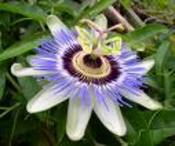 I wanted to share this picture.
I wanted to share this picture.
This is one of those "air plants" my partner and I picked up at the Brooklyn Botanic Gardens, our local gem. Though you can’t see it in this picture (and be sure to click on it to see it enlarged), it isn’t sitting in any soil whatsoever (it is in the window, on the sill, of our shower). It sits on top of the wood chips that cover the roots of another plant we have in the bathroom, an orchid plant.
This morning, for the sixth time, the purple "protuberance,"…erection, if you will…you see on the right, has pushed it’s way up and out of the ensiform, or sword-shaped "structure" (iris leaves are "ensiform"…and I’m not sure if this is a flower or the purple bloom is the flower…) that sits on the gray, woody stalk of the air plant. I may be mistaken, but I believe this plant is either a bromeliad, or closely related to them.
The technical name for the air plant and bromeliads are "epiphytic plants," amazing because they do not require soil to grow. Because there is no soil, watering is, in the main, via humidity. If you visit the Brooklyn Botanic Garden, (and I highly recommend it and the Steinhardt Pavilions where there are bonsai in what they call the Starr Bonsai Museum that are more than 125 years old and very lovely botanical art downstairs) which we do almost weekly, you can see these plants hanging in mid-air in the orchid pavilion, plants to which they are also related.
Air plants derive their nutrition from the air, rain water nutrients and decomposing matter (mostly leaves and dead insects) that may be caught among their air roots or in their leaves. Another incredible example, epiphytic plants absorb nitrogen in the air produced by lightning! In the wild, most epiphytic plants are attached to tree bark as a brace but do not in any way feed off the tree.
Anyway…every time it blossoms it is amazing to me, and I wanted to share it and preserve it in some way. Each of the individual components of this ensiform structure has had one of these beautiful purple blooms, tipped with the tiny plume.
We’ve also had pretty good luck with passion flowers actually fruiting! This is the flower we got on the right, and a picture of the fruit on the left: 
